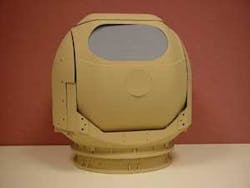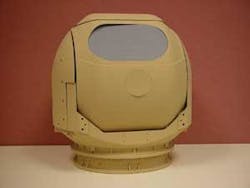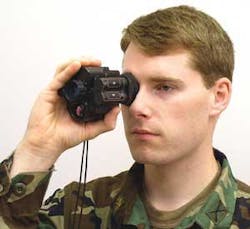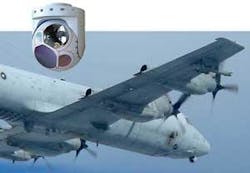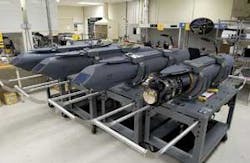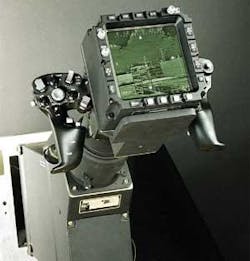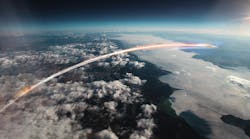Tomorrow’s sensors will be modular, digital, fused, and networked
By Ben Ames
Soldiers who use optical sensors for military surveillance have tough demands. They want long-range lenses for standoff distance, infrared cameras to see heat traces at night, and laser illuminators to see targets through night-vision goggles.
These next-generation optical sensors are useless without a simple tool - the zoom lens. To find a specific target, troops must first look through a wide-field-of-view camera, then zoom in to a smaller view. Starting with a larger lens would be like trying to read a newspaper while peeking through a soda straw.
Once they have found the proper target, troops will pick the most appropriate optical sensor for the job - surveillance, reconnaissance, target designation, or range finding.
For these kinds of demands, designers at L-3 Wescam in Burlington, Ontario, design modular sensors, says Paul Jennison, vice president of government sales and business development. The company makes electro-optical infrared (EOIR) imaging turrets for helicopters and unmanned aerial vehicles.
Their MX-12 is a 12-inch-diameter dome that contains as many as to six sensors, including high-magnification infrared, color daylight camera with zoom or spotter lens, laser illuminator, or laser rangefinder. It weighs between 55 and 70 pounds, light enough to fit on a small unmanned aerial vehicle (UAV).
Customers who need more options can choose the MX-20, a 20-inch-diameter turret weighing as much as 155 pounds that requires a larger airframe than a typical UAV. In return, users can install advanced sensors such as a multispectral imager for day and night use, longer lenses than the MX-12, better image processing, and military-standard ruggedness.
The MX-20 now flies on the U.S. Navy P-3 maritime patrol airplane, and the Coast Guard C-130 Hercules search-and-rescue airplane. Experts from those services chose the MX-20 so they could use its long, 3200-millimeter lens, capable of spotting a small boat 40 nautical miles away, Jennison says.
“A year and a half ago, we could pack just four sensors into the MX-15 and MX-20, but now we fit six sensors into these,” he says. “And of course customers want a stable image, so our job is to stabilize it from vibration and wind buffeting.”
Another challenge is technology refresh. L-3 Wescam engineers trade the cheaper cost of commercial off-the-shelf (COTS) components for frequent obsolescence; they must replace cameras every 24 to 30 months to ensure that manufacturers will continue to service them.
The next step is to move from analog to digital imagery. Customers are demanding digital data so they can feed the pictures to powerful image-processing computers, and then share them through wireless links. L-3 Wescam officials say they plan to achieve that capability within 18 months, he says.
Another long-term goal is hyperspectral imaging, a way to combine hundreds of bandwidths in a single image. Satellite engineers have used the technique for years to perform crop surveillance, and military users now want to use it to see through camouflage.
Sensor fusion
In October leaders of the U.S. Air Force awarded a $40 million contract to ITT Industries Night Vision systems in Roanoke, Va., for AN/AVS-9 night vision goggles. Air crews will wear the goggles to fly aboard H-60 helicopters, KC-135 and KC-10 tankers, and C-17 and C-130 transport aircraft.
Troops have used two kinds of night-vision goggles for years, picking either infrared imaging to track targets by their heat traces or image intensification to see the landscape by starlight. Both methods have weaknesses - the visible light viewer cannot see through smoke or fog, while the infrared viewer cannot see through glass.
Now U.S. Army leaders want to combine the two methods into one unit, which they have dubbed the enhanced night-vision goggle (ENVG).
ITT Night Vision is bidding for a contract to supply the new unit; the company won a 2003 research contract to supply 75 ENVG systems to Army testers, and has continued to make improvements.
Their prototype uses two sensors - a far-infrared sensor from Raytheon Network Centric Systems in Plano, Texas, and a visible and near-infrared sensor from ITT, says Jim Harris, vice president and director of engineering for ITT Industries Night Vision.
ITT engineers overlay the images with a beam combiner, so a soldier looking through the device has a direct view to his target, as if he were gazing through binoculars.
Digital pictures
In another project, Army leaders want to convert night-vision images from analog to digital.
As part of the Future Force Warrior program, Army planners have called for electronic images of the battlefield, generated by an electronic image intensifier. In July, ITT engineers won a development contract to create a sample device by late 2005, with working prototypes by mid-2006.
Soldiers could then share pictures with each other or with a remote command center. Because the images would be digital, they could also add data such as GPS coordinates and battlefield symbology, according to a contract from the Army’s Night Vision and Electronic Sensors Directorate at Fort Belvoir, Va., administered by CACI Technologies Inc. in Arlington, Va.
ITT engineers would create the new device by attaching a complementary metal-oxide semiconductor (CMOS) detector to their existing image intensifier, Harris says. Because the detector would take digital pictures of each view, a soldier will no longer be able to look directly at his target; instead the sensor will be mounted on his helmet, and he will see the image on a small screen.
To make the system work, engineers face additional challenges such as compressing the data, reducing the weight of electronics on the helmet, and extending battery life.
“Current goggles use two AA batteries to run a monocular for 60 hours. But you need four batteries for 15 hours if you add a thermal camera. And to go to full digital you would need even more,” Harris says.
Networked sensors
Designers at Raytheon are creating a medium-range electro-optical infrared (EOIR) sensor for the Army’s Future Combat System (FCS). The $75 million program is part of a larger contract for next-generation integrated sensors.
Soldiers will use the device for target engagement, fire control, and situational awareness in any weather. In addition, the system locates targets for line-of-sight or non-line-of-sight fire using optics, wide-area search, multispectral image processing, active illumination (shortwave infrared) with laser designation, and range finders.
“From the customer’s point of view, sensors are where the critical mass is with their investment,” says Johnny Garrett, director of integrated systems at Raytheon Network Centric Systems.
Soldiers in FCS vehicles will use a low-light television sensor to see the battlefield around them, including color images so they can read the markings on target vehicles. That camera will use an illuminating laser to act as a long-range flashbulb for night viewing, and another laser for range finding and target designation. A thermal imager will let them read heat signatures.
These sensors will feed data to soldiers’ displays and the vehicle’s computers. “Image processing needs lots of data storage, from TV cameras and FLIRs, to storing it for future use, to handing it off to others through wireless connections,” Garrett says.
In battle, soldiers will scan a wide area of the battlefield, and then let software algorithms perform automatic target detection and recognition. Automatic recognition is crucial in battle because soldiers get fatigued as they monitor sensors for hours in remote mountain passes or on chaotic battlefields.
Raytheon leaders will roll this technology out from 2007 to 2010. “We’re doing design startup now; the contract was awarded in August, but the fundamental technology is already mature,” Garrett says. “We can gather the technology from other programs, so our real work is in integration and software.”
Raytheon already produces components like the focal-plane array and television cameras. They will pick a multi-spectral device for the thermal imager, capable of using a single chip to produce the 3-to-5-micron mid-range spectrum and the 8-to-12-micron long-range spectrum. And they must choose packaging materials that are strong, lightweight, and have a low radar signature.
Finally, each sensor must fit into the total network. The EOIR unit must interact with other FCS sensors like Combat Identification (CID) - the millimeter-wave radio-frequency signal used to identify friendly and unknown forces - and like the Multifunction Radio Frequency (MFRF) sensor, an electronically scanned radar array that will provide hemispherical coverage around the vehicle.
That means they must share bandwidth on the networked battlefield.
“Those machines will always be grinding away, so bandwidth is all-important to ensure that networks are not overloaded,” Garrett says. “We must send the appropriate amount of information to share high-fidelity data but not burden the network with the mundane.”
The entire package is part of a $223 million contract that the Army awarded to Raytheon in August. As part of the Army’s planned Objective Force, the FCS will use networking, sensors, and information fusion to create situational awareness and operation synchronization. Its new capabilities will include networked sensors, advanced command and control, agile platforms, and precision effects, all supporting the Army vision of network-centric warfare.
Fighting with sensors
Optical sensors are crucial fighting tools for U.S. airplanes and helicopters. Three examples of future sensor packages demonstrate how deadly they can be.
Army pilots of the Apache helicopter need an optoelectronic fire-control system to help them fly and fight in any weather. They use Arrowhead, the Modernized Target Acquisition Designation Sight/Pilot Night Vision Sensor (TADS/PNVS) from Boeing in St. Louis and Lockheed Martin Missiles and Fire Control in Orlando, Fla. The first unit is scheduled to reach the field in 2005.
Arrowhead designers applied the Army’s philosophy of horizontal technology integration, sharing components and software that had been designed for the cancelled Comanche helicopter program. Examples include the targeting receiver, image-intensified television, forward-looking infrared electronics, and advanced video processors. The design also includes a growth path to reach image fusion and airborne aided target designation.
Air Force pilots aboard F-15 and F-16 fighter jets need a tool for target detection and identification.
They chose Sniper XR, an advanced targeting pod (ATP) that uses high-resolution FLIR, a dual-mode laser, and CCD-TV along with a laser spot tracker, laser marker, and image-processing algorithms. The pod can automatically track and designate tactical-size targets, and show the results to pilots on a real-time cockpit display. Lockheed Martin engineers designed the pod to fit those capabilities into a streamlined, eight-foot-long tube weighing 397 pounds.
Future pilots of the F-35 Joint Strike Fighter will need a precision device for air-to-air and air-to-surface targeting.
They will use the Electro-Optical Targeting System (EOTS) from Lockheed Martin and BAE Systems. The 200-pound EOTS fits inside an angular sapphire window, attached to the “chin” of the fighter’s fuselage. It shares data with the aircraft’s central computer with a fiber-optic interface.
The unit deploys FLIR for target detection, and provides high-resolution imagery, automatic tracking, infrared search-and-track, laser designation and range finding, and laser spot tracking.
EOTS is built by engineers at Lockheed Martin and BAE Systems, as part of the fighter’s Electro-Optical Sensor System (EOSS), built by the team of Lockheed Martin and Northrop Grumman Electronic Systems. The other EOSS component is Northrop Grumman’s Distributed Aperture System, which provides 360-degree situational awareness.
